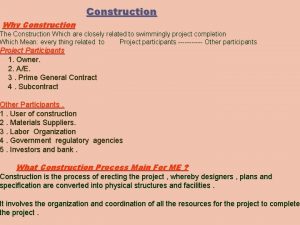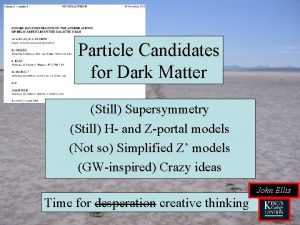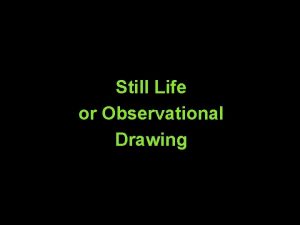Note The Following Lecture is Still UNDER CONSTRUCTION






































- Slides: 38

Note! The Following Lecture is Still UNDER CONSTRUCTION!!! Much of it comes from lectures by others that I found on the internet!

Special Topic: “Perpetual Motion” & The Laws of Thermodynamics

What is “Perpetual Motion”? “Perpetual Motion” • Describes HYPOTHETICAL MACHINES that operate or produce useful work indefinitely &, more generally, hypothetical machines that produce more work or energy than they consume, whether they might operate indefinitely or not. • There is undisputed scientific consensus that Perpetual motion would violate either the 1 st Law or the 2 nd Law of Thermodynamics, OR BOTH!

“Perpetual Motion” • Describes a theoretical machine that, without any losses due to friction or other forms of dissipation of energy, would continue to operate indefinitely at the same rate without any external energy being applied to it. • Machines which comply with both the 1 st & 2 nd Laws of Thermodynamics but access energy from obscure sources are sometimes referred to as “Perpetual Motion” machines, although they do not meet the standard criteria for the name.

Classification of “Perpetual Motion” Machines! 1. “Perpetual Motion” Machine” of the 1 st Kind 2. “Perpetual Motion” Machine of the 2 nd Kind 3. “Perpetual Motion” Machine of the 3 rd Kind

The 1 st Kind • A “perpetual motion” machine of the first kind produces work without the input of energy. It thus violates the 1 st Law of Thermodynamics: the Law of conservation of energy. • • • The law of conservation of energy is an empirical law of physics. It states that the total amount of energy in an isolated system remains constant over. A consequence of this law is that energy can neither be created nor destroyed: it can only be transformed from one state to another. So, It is clearly impossible for a machine to do the work infinitely without consuming 6

Examples of the 1 st Kind of “Perpetual Motion” Machine The Overbalanced Wheel The Float Belt The Capillary Bowl

Overbalanced Wheel • The "Overbalanced Wheel". • It was thought that the metal balls on the right side would turn the wheel because of the longer lever arm. But! Since the left side had more balls than the right side, the torque was balanced and the perpetual movement could not be achieved.

Overbalanced Wheel

The Float Belt • The yellow blocks indicate • floaters. It was thought that the floaters would rise through the liquid and turn the belt. However pushing the floaters into the water at the bottom would require more energy than the floating could generate!

Perpetual Motion: Float Belt Hollow balls float up through water, only to be pulled back down as they descend in air.

Perpetual Motion: Float Belt Why doesn't this work? 1. There is no way to push the balls in at the bottom without losing water. 2. Pushing the balls in at the bottom will take at least as much energy as gained from the balls floating up and the falling down. 3. This will work only so long as the water is cooler than the ping pong balls. 4. A team at Brookhaven is now nearing break-even energy for device that works on the same principle.

Perpetual Motion: Float Belt Why it doesn't work: 2. Pushing the balls in at the bottom will take at least as much energy as gained from the balls floating up and the falling down.

The Capillary Bowl • The "Capillary Bowl". It was • thought that the capillary action would keep the water flowing in the tube. But since the cohesion force that draws the liquid up the tube in the first place holds the droplet from releasing into the bowl, the flow is not perpetual.

Capillary Bowl It was thought that the capillary action would keep the water flowing in the tube, but since the cohesion force that draws the liquid up the tube in first place holds the droplet from releasing into the bowl, the flow is not perpetual.

The Second Law of Thermodynamics • It is impossible to extract an amount of heat QH from a hot reservoir and use it all to do work. • Some amount of heat QC must be exhausted to a cold reservoir. This precludes a perfect heat engine.

Perpetual Motion Machine: Second Kind This type of perpetual motion machine uses heat as a power source directly and continuously, without the flow of heat to a sink. This violates the second law of thermodynamics. 2 nd Law: "Heat (macroscopically) cannot flow spontaneously from a material at lower temperature to a material at higher temperature. "

The second kind • • A perpetual motion machine of the second kind is a machine which spontaneously converts thermal energy into mechanical work. When thermal energy is equivalent to the work done, this does not violate the law of conservation of energy. However it does violate the more subtle second law of thermodynamics. The signature of a perpetual motion machine of the second kind is that there is only one heat reservoir involved, which is being spontaneously cooled without involving a transfer of heat to a cooler reservoir. This conversion of heat into useful work, without any side effect, is impossible, according to the second law of thermodynamics.

Perpetual Motion Machine: Third Kind This type of perpetual motion machine relies on eliminating friction. Technically, this is not so much an energy generating machine so much as an energy storage device. It is not possible to move with zero friction, so although low friction devices are real, zero friction devices are not.

• A perpetual motion machine of the third kind, is usually (but not always) defined as one that completely eliminates friction and other dissipative forces, to maintain motion forever. This can’t happen because it is impossible for dissipation to reach 100%.

• Although a perpetual motion machine is impossible , people still attempt to improve their way to use energy. • We try to decrease the energy wasted during the processes of energy transaction and transportation so that we can use it more effectively.

Wind Power Solar Energy Hydropower 22

You Can’t Patent Perpetual Motion Machines Because They Would Violate the 1 st and/or the 2 nd Laws of Thermodynamics

Illusions

Why it can’t happen… • A perpetual motion machine violates the law of conservation of energy or the second law of thermodynamics or both. • A perpetual motion machine of the first kind produces energy from nothing, giving the user unlimited 'free' energy. It thus violates the law of conservation of energy. • A perpetual motion machine of the second kind is a machine which spontaneously converts thermal energy into mechanical work. Since only one single heat reservoir is involved that is being spontaneously cooled without involving a transfer of heat to a cooler reservoir it violates the second law of thermodynamics.

Howard Johnson

Perendev Magnetic Motor?

Perpetual Motion Machine: Useful Thought Experiments At least two classic thought experiments seem to create perpetual motion machines. • Maxwell's Demon (analyzed in another lecture) • Brownian Rachet Wheel

Perpetual Motion: Brownian Ratchet Wheel

Perpetual Motion: Brownian Ratchet Wheel A ratchet wheel with cogs has a paw that allows it only to rotate in one direction. Random brownian motion of the air molecules strike the wheel, sometimes causing enough motion so that it clicks forward one cog. The paw prevents it from even clicking back. Is the slow rotation of the wheel perpetual motion? 1. Yes, you've done it! 2. No. 3. It depends in how many dimensions the paw can move.

Perpetual Motion: Brownian Ratchet Wheel No. The wheel will only rotate as expected when the ratchet and paw are significantly colder than the surrounding air or the heat bath. Then the device works by tapping into the heat flowing from the heat bath to the wheel. When everything is the same temperature, the paw may have its own Brownian motion and will allow the wheel to go in either direction.

Perpetual Motion: Magnetic Tower Balls are pulled up a ramp by a powerful permanent magnet but then drop through a hole at the top, returning them to their original position.

Perpetual Motion: Magnetic Tower Why doesn't this work? 1. Any magnet powerful enough to pull the balls up the ramp would be powerful enough to keep them from dropping through the hole. 2. The rolling ball would at first be attracted to the magnet, but after it rolled its polarity would reverse and it would then be repelled from the magnet. 3. The system works, but there is no way to extract power. 4. The electric companies kill anyone who gets too close to making this work to protect the profit of their investors.

Perpetual Motion: Magnetic Tower Why it doesn't work: 1. Any magnet powerful enough to pull the balls up the ramp would be powerful enough to keep them from dropping through the hole.

Perpetual Motion: Conservative Forces A conservative force creates work on a particle that is independent of the path taken. Therefore, paths that return to their starting point can gain no work -- no energy. Therefore, a conservative force field cannot be used to create a perpetual motion machine that generates energy. Examples of conservative force field include Newtonian gravitational force and Coulomb electric force.

Perpetual Motion Machines: The US Patent Office Many people try to patent their own perpetual motion machines. The US Patent office will no longer grant patents to machines that it feels are perpetual motion power generators, without a working model. Some people try to create machines so complex that no one could determine their efficiency without such a model.

Perpetual Motion Machines: Complex Hoaxes Examples: Machines that are powered by a cleverly hidden person. http: //www. museumofhoaxes. com/hoax/Hoaxipedia/ Perpetual_Motion_Machine_of_Charles_Redheffer/

Perpetual Motion Machines: Advice If you have created a true perpetual motion machine from which you create free energy, please do not hold press conferences and tell everyone. Please start creating power from your machine and selling it. The electric company MUST buy it, and you can make a fortune.
 01:640:244 lecture notes - lecture 15: plat, idah, farad
01:640:244 lecture notes - lecture 15: plat, idah, farad Lecture notes tiu
Lecture notes tiu Difference between note making and note taking
Difference between note making and note taking Abbreviation for continued
Abbreviation for continued Difference between note making and note taking
Difference between note making and note taking Goods received note vs delivery note
Goods received note vs delivery note Debit note and credit note
Debit note and credit note Nota debit adalah
Nota debit adalah Note making advantages
Note making advantages A simple discount note results in
A simple discount note results in Project management lecture notes
Project management lecture notes Put the words under the following headings
Put the words under the following headings Hình ảnh bộ gõ cơ thể búng tay
Hình ảnh bộ gõ cơ thể búng tay Ng-html
Ng-html Bổ thể
Bổ thể Tỉ lệ cơ thể trẻ em
Tỉ lệ cơ thể trẻ em Chó sói
Chó sói Chụp phim tư thế worms-breton
Chụp phim tư thế worms-breton Bài hát chúa yêu trần thế alleluia
Bài hát chúa yêu trần thế alleluia Các môn thể thao bắt đầu bằng từ đua
Các môn thể thao bắt đầu bằng từ đua Thế nào là hệ số cao nhất
Thế nào là hệ số cao nhất Các châu lục và đại dương trên thế giới
Các châu lục và đại dương trên thế giới Công thức tính thế năng
Công thức tính thế năng Trời xanh đây là của chúng ta thể thơ
Trời xanh đây là của chúng ta thể thơ Cách giải mật thư tọa độ
Cách giải mật thư tọa độ 101012 bằng
101012 bằng Phản ứng thế ankan
Phản ứng thế ankan Các châu lục và đại dương trên thế giới
Các châu lục và đại dương trên thế giới Thơ thất ngôn tứ tuyệt đường luật
Thơ thất ngôn tứ tuyệt đường luật Quá trình desamine hóa có thể tạo ra
Quá trình desamine hóa có thể tạo ra Một số thể thơ truyền thống
Một số thể thơ truyền thống Cái miệng nó xinh thế chỉ nói điều hay thôi
Cái miệng nó xinh thế chỉ nói điều hay thôi Vẽ hình chiếu vuông góc của vật thể sau
Vẽ hình chiếu vuông góc của vật thể sau Thế nào là sự mỏi cơ
Thế nào là sự mỏi cơ đặc điểm cơ thể của người tối cổ
đặc điểm cơ thể của người tối cổ Giọng cùng tên là
Giọng cùng tên là Vẽ hình chiếu đứng bằng cạnh của vật thể
Vẽ hình chiếu đứng bằng cạnh của vật thể Fecboak
Fecboak Thẻ vin
Thẻ vin






























































